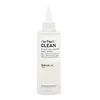What's inside
What's inside
 Key Ingredients
Key Ingredients

 Benefits
Benefits

 Concerns
Concerns

 Ingredients Side-by-side
Ingredients Side-by-side

Water
Skin ConditioningPEG-40 Hydrogenated Castor Oil
EmulsifyingAlcohol Denat.
AntimicrobialGlycerin
HumectantPropylene Glycol
HumectantSorbitol
HumectantVinegar
Menthol
MaskingSaccharomyces/Rice Ferment Filtrate
Skin ConditioningHydrolyzed Corn Protein
Skin ConditioningHydrolyzed Wheat Protein
Skin ConditioningHydrolyzed Soy Protein
HumectantPanax Ginseng Root Extract
EmollientLeuconostoc/Radish Root Ferment Filtrate
AntimicrobialShea Butter Ethyl Esters
EmollientSodium Hyaluronate
HumectantPentylene Glycol
Skin ConditioningButylene Glycol
HumectantXanthan Gum
EmulsifyingEthylhexylglycerin
Skin ConditioningDisodium EDTA
Sodium Hydroxide
BufferingPhenoxyethanol
PreservativeT-Butyl Alcohol
PerfumingParfum
MaskingLinalool
PerfumingWater, PEG-40 Hydrogenated Castor Oil, Alcohol Denat., Glycerin, Propylene Glycol, Sorbitol, Vinegar, Menthol, Saccharomyces/Rice Ferment Filtrate, Hydrolyzed Corn Protein, Hydrolyzed Wheat Protein, Hydrolyzed Soy Protein, Panax Ginseng Root Extract, Leuconostoc/Radish Root Ferment Filtrate, Shea Butter Ethyl Esters, Sodium Hyaluronate, Pentylene Glycol, Butylene Glycol, Xanthan Gum, Ethylhexylglycerin, Disodium EDTA, Sodium Hydroxide, Phenoxyethanol, T-Butyl Alcohol, Parfum, Linalool
Water
Skin ConditioningAlcohol Denat.
AntimicrobialIsopentyldiol
HumectantVinegar
Butylene Glycol
HumectantBetaine
HumectantPEG-60 Hydrogenated Castor Oil
EmulsifyingErythritol
HumectantStearamidopropyl Dimethylamine
EmulsifyingLactic Acid
BufferingOctyldodeceth-16
EmulsifyingSodium Benzoate
MaskingSodium Gluconate
Skin ConditioningMentha Piperita Oil
MaskingCetrimonium Chloride
AntimicrobialSodium Lactate
BufferingMenthol
MaskingSalicylic Acid
MaskingMentha Piperita Extract
CleansingMentha Viridis Extract
MaskingDisodium EDTA
Eucalyptus Globulus Leaf Oil
PerfumingMentha Rotundifolia Leaf Extract
TonicMelaleuca Alternifolia Leaf Oil
AntioxidantLimonene
Perfuming1,2-Hexanediol
Skin ConditioningFructan
Skin ConditioningCarthamus Tinctorius Flower Extract
Skin ConditioningUrtica Dioica Extract
AstringentViola Mandshurica Flower Extract
AntioxidantEquisetum Arvense Extract
AstringentOenothera Biennis Flower Extract
AstringentPaeonia Albiflora Root Extract
Skin ConditioningPinus Palustris Leaf Extract
TonicPrunus Persica Fruit Extract
AbrasivePueraria Lobata Root Extract
HumectantSwertia Japonica Extract
Skin ConditioningUlmus Davidiana Root Extract
Skin ConditioningEthylhexylglycerin
Skin ConditioningWater, Alcohol Denat., Isopentyldiol, Vinegar, Butylene Glycol, Betaine, PEG-60 Hydrogenated Castor Oil, Erythritol, Stearamidopropyl Dimethylamine, Lactic Acid, Octyldodeceth-16, Sodium Benzoate, Sodium Gluconate, Mentha Piperita Oil, Cetrimonium Chloride, Sodium Lactate, Menthol, Salicylic Acid, Mentha Piperita Extract, Mentha Viridis Extract, Disodium EDTA, Eucalyptus Globulus Leaf Oil, Mentha Rotundifolia Leaf Extract, Melaleuca Alternifolia Leaf Oil, Limonene, 1,2-Hexanediol, Fructan, Carthamus Tinctorius Flower Extract, Urtica Dioica Extract, Viola Mandshurica Flower Extract, Equisetum Arvense Extract, Oenothera Biennis Flower Extract, Paeonia Albiflora Root Extract, Pinus Palustris Leaf Extract, Prunus Persica Fruit Extract, Pueraria Lobata Root Extract, Swertia Japonica Extract, Ulmus Davidiana Root Extract, Ethylhexylglycerin
 Reviews
Reviews

Ingredients Explained
These ingredients are found in both products.
Ingredients higher up in an ingredient list are typically present in a larger amount.
Alcohol Denat. is an alcohol with a denaturant property. It is created by mixing ethanol with other additives.
This ingredient gets a bad rep because it is irritating and drying - mostly due to its astringent property. Astringents draw out natural oils in tissue, constricting pores and leaving your skin dried out.
However, alcohol denat. is not all that bad.
Due to its low molecular weight, alcohol denat. tends to evaporate quickly. One study on pig skin found half of applied alcohol evaporated in 10 seconds and less than 3% stayed on skin.
This also helps other ingredients become better absorbed upon application.
Studies are conflicted about whether this ingredient causes skin dehydration. One study from 2005 found adding emollients to propanol-based sanitizer decreased skin dryness and irritation. Another study found irritation only occurs if your skin is already damaged.
Small amounts of alcohol are generally tolerated by oily skin or people who live in humid environments.
The rule of thumb is if this alcohol is near the end of an ingredients list, it will probably not affect your skin much.
Also...
This ingredient has antimicrobial and solvent properties.
The antimicrobial property helps preserve products and increase their shelf life. As a solvent, it helps dissolve other ingredients.
Other types of astringent alcohols include:
Learn more about Alcohol Denat.Butylene Glycol (or BG) is used within cosmetic products for a few different reasons:
Overall, Butylene Glycol is a safe and well-rounded ingredient that works well with other ingredients.
Though this ingredient works well with most skin types, some people with sensitive skin may experience a reaction such as allergic rashes, closed comedones, or itchiness.
Learn more about Butylene GlycolDisodium EDTA plays a role in making products more stable by aiding other preservatives.
It is a chelating agent, meaning it neutralizes metal ions that may be found in a product.
Disodium EDTA is a salt of edetic acid and is found to be safe in cosmetic ingredients.
Learn more about Disodium EDTAEthylhexylglycerin (we can't pronounce this either) is commonly used as a preservative and skin softener. It is derived from glyceryl.
You might see Ethylhexylglycerin often paired with other preservatives such as phenoxyethanol. Ethylhexylglycerin has been found to increase the effectiveness of these other preservatives.
Menthol is a compound found in mint plants, such as peppermint. In its pure form, it is a clear crystalline substance.
Menthol is known for its cooling sensation; however, the cooling is actually from your skin being sensitized. Menthol can worsen rosacea. We recommend speaking with a professional if you have concerns.
Menthol also has antimicrobial properties.
Learn more about MentholIn cosmetics, vinegar is often used to help adjust the pH of a product. It is also a light exfoliant. The pH of your skin is important to maintain a healthy skin barrier.
Vinegar is created by the process of double-fermentation. It is an aqueous solution consisting mostly of water and acetic acid. Typically, vinegar contains anywhere from 5-8% acetic acid.
Other components include small amounts of contains small amounts of tartaric acid and citric acid. Depending on what is used to ferment the vinegar, it can have traces of flavoring as well.
Learn more about VinegarWater. It's the most common cosmetic ingredient of all. You'll usually see it at the top of ingredient lists, meaning that it makes up the largest part of the product.
So why is it so popular? Water most often acts as a solvent - this means that it helps dissolve other ingredients into the formulation.
You'll also recognize water as that liquid we all need to stay alive. If you see this, drink a glass of water. Stay hydrated!
Learn more about Water